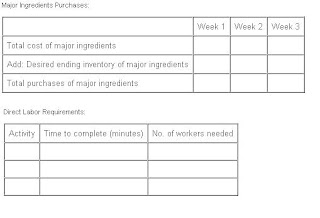Your technical section must define the following:
* Production process
* Your property, plant, and equipment
* Physical layout and waste disposal
* Production schedules and manpower
How do I make a business plan? (2)
Marketing is the first and most important part of your business plan. (Second of a two-part series) How do I make a business plan? Part 1 |How do I make a business plan?Part 2
Q: Our company is offering us a one-time loan which I plan to invest in a carinderia. I have talked to my high school friend who is a good cook to help me out in establishing this business. I only have PhP 150,000 to start with. My family is committed to support me with manpower since most of my relatives are currently unemployed.
Currently I have been browsing the internet for materials that could help me build the business plan, cash flow, and feasibility. What other things should I need to consider?
--Teddy U. Tabanao Jr.
In the technical plan, you convert your sales projections into production volume. You need to go through your production details. It all starts and ends with the basic question: How many orders will you cook for each dish?
Production Process
Look at your carinderia in the light of a manufacturing activity. Document everything at the start and every time you cook a new dish.
Unnecessary costs often arise due to poor production planning. Any business requires proper production planning.
Firstly, you can identify the common ingredients that you need for the different dishes that you cook for the day, the day after, or even for the whole week. Secondly, you can determine how much time and resources you need. Review these steps:
* Materials preparation: Acquiring and preparing the ingredients.
* Cooking process: Your recipe, your step-by-step formula.
* Finishing process and packaging: Garnishing, arrangement, and packing.
* Delivery: Serving and orders by telephone.
Documenting the process enables you to assign somebody to take over from your cook when he or she is not available. It also prevents you from being overly dependent on the former.
Your Property, Plant, and Equipment
Review the assets you need for your carinderia, from where you will buy them, and how much each one will to cost.
As in many carinderias, you may use your existing equipment such as stoves, toasters, refrigerator, freezer, and utensils. There is nothing wrong with the idea for as long as their use in the business isn?t hampered by household use.
Physical Layout and Waste Disposal
How will you arrange your equipment, work area, and dining area relative to one another? How much space will you need, including storage areas? Will it be able to accommodate the kitchen and serving area for a certain number of people during mealtimes?
Knowing the steps will help you determine where you can put your equipment and furniture. Determine the locations of electrical outlets and water sink, and the size of the eating area.
Create a layout that will reduce crisscrossing of activities, eliminate backtracking, and provide a smooth flow of production. This will reduce costs and improve work efficiency.
More questions: How will you dispose of the carinderia?s waste? Can you sell them? Can you recycle them? Will you need to spend for their disposal? How much?
Production Schedules and Manpower
The purpose of this schedule is to ensure that you meet your sales projections.
It is concerned with inventory of direct materials (major ingredients) and indirect materials (minor ingredients including other serving supplies). It is also concerned with how many units you actually need, how many units you should keep as reserve, and how much it will all cost. Other businesses would keep an inventory of finished goods but this does not apply to your case.
The following tables will guide you. Prepare a weekly schedule for the first month, then a monthly schedule afterwards until the end of your first year. Afterwards, you can use the data to make yearly schedule.
Make a table or schedule for each dish you intend to serve. The beauty of drawing a production plan and preparing production tables for each dish is you will be guided in identifying the level of skills you will need, distributing the tasks to the workers in a manner that they are kept busy, as well as in optimizing the use of your equipment.
Weekly Production (click the table to see a readable, larger version):

Following the format of the tables for the major ingredients, you may proceed to prepare the schedule for the minor ingredients for each dish.
Review your step-by-step cooking process and the time needed to complete each process. Given your production volume, how many people will you need to complete each step?
This makes up your technical/production plan. Go over it once again and make sure that you did not miss out on anything. By this time you may have realized that the four sections are closely interdependent and interrelated. I suggest that you take your time in completing this part since this is the heart of your business.
“SmallBiz Clinic” is a joint project of EYP and the UP Institute for Small-Scale Industries (UP ISSI) that aims to provide free online consultancy and information services to small and medium-scale enterprises. A team of expert consultants from UP ISSI answers questions sent in by SME readers and advises them on general actions to take to better manage their businesses.
The UP ISSI is a training and research organization created in 1966 to help promote the development of small enterprises in the country. It has trained generations of successful Filipino entrepreneurs via comprehensive development programs in management, marketing, and finance, as well as other innovative development strategies such as the training of small business consultants.
UP ISSI brings to the “SmallBiz Clinic” over 35 years of frontline expertise in the day-to-day challenges and issues of running a Philippine-based enterprise.
Source: Philstar




No comments:
Post a Comment